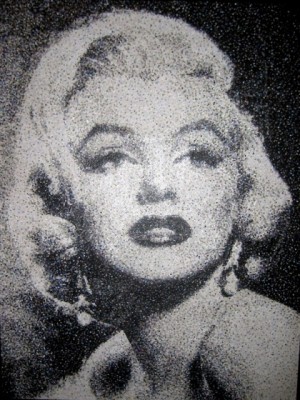Artist of the Week 10/24-10/30: Nikki Douthwaite Makes Art in the Fast Lane – Dots and All
Nikki Douthwaite is obsessed. No, not like Tony Shalhoub’s famously germaphobic detective in the TV series Monk, but really obsessed.
The obsession — dots. Hundreds, thousands, hundreds of thousands of them, all immaculately punched together.
Up close, they seem meaningless, a jumble more abstract than anything else. But viewed from a distance, Douthwaite’s “dot art” takes on a new life, showing the faces of famous motorsports and pop culture figures in stunning clarity.
It takes a fair distance to be able to decipher Douthwaite’s portraits for good reason: they’re huge. In fact, one of her works, In Seine (completed June 2008), holds the Guinness World Record as the largest confetti mosaic on Earth. Containing more than 587,000 hole-punched dots and measuring roughly 10 feet by seven feet, it only took her four months to complete. Created as the final project for her art degree, one has to assume she found time to sleep while working on it.
But Douthwaite is more than just the “dot lady.” Though her life in the United Kingdom with her dog Maggie might seem tranquil enough, she also has another passion: racing. A huge Formula 1 (F1) fan, a large portion of her works have featured famous F1 drivers, many of whom she’s personally met as a result of the fame she’s garnered through such outlets as F1 Racing Magazine and the BBC. Along the way, she’s also had work commissioned by none other than car manufacturer/racing sponsor McLaren, whose super-charged automobiles would make even James Bond blush.
After traversing a stretch of highway at speeds far beyond the legal limit in a suit wildly incongruous – a word which here means “inappropriate” – given the weather, GALO was able to catch up with Douthwaite. Here’s what she had to say.
GALO: How did you get your start with dot art? Why dots at all?
Nikki Douthwaite: For my degree [from] 2005-2008, I had been concentrating on optical mixing and color relationships. As a part of that, I studied Georges Pierre Seurat and his famous painting A Sunday Afternoon on the Island of La Grande Jatte. Having been to Paris several times and being a little in love with the city, I headed to Paris to find what he would see if he sat there in 2008. I decided to make a modern day version of his picture [of] the same size and parameters as he did in 1886. I drew out and photographed my findings. In previous projects, I had used hole punch dots, buttons, drawing pins, and other circular “dot” type mediums, but settled on hole punch dots for a few reasons: [first] the hole punch dots had an endless color pallet, [and secondly] I couldn’t find any large pieces of work, or any artist recorded to be using this medium, and [lastly] the hole punch was invented during the time Seurat had painted the original picture.

“John Lennon” made with about 99,000 dots on wood by Nikki Douthwaite. 158cm by 122cm, completed March 2011. Photo Courtesy of: Nikki Douthwaite.
GALO: What is the creative process like for you?
ND: Basically I am nothing short of “addicted” to sticking dots. I suffer from OCD, and finally found a productive outlet for my condition. No more sorting out thousands of jelly beans into color order!
That is why I spend so many hours a day working; I find it addictive. Each picture — even the black and white ones — have hundreds of colors, and every one is different, even if they look black and white from a distance. Close up, the color pallet is quite different, every one is unique.

“John Lennon” detailed view. Photo Courtesy of: Nikki Douthwaite.
GALO: How do you choose a subject for your dot art, and why the emphasis on racecar drivers? Why not, say, animals or nature?
ND: I took three years of life drawing classes, and was interested (I did three years of nurse training many years ago) in bone structures and became a little into faces and expression. I am a huge motorsport fan, especially Formula 1. I have scheduled my life around the F1 calendar for about 20 years. When I came to make my first piece post degree, I watched Lewis Hamilton win the British Grand prix the day before I graduated, [and] as a huge McLaren fan, I just wanted to give it a go. I had done some small sample portraits of my loved ones the year before, so I set about making a portrait of him, for two and a half months. I finished one week before he won the world championship. After making Lewis, I was invited down to meet the McLaren team and sold my first piece of art to the boss of McLaren, Ron Dennis, who was a hero of mine. At that point, I knew I wanted to make them a collection of [their entire] past world championships.
All the non-F1 pieces have been paid commissions, so not my choice, but they have paid my rent and allowed me to carry on making my McLaren dot collection, hopefully to be finished in January.
After that collection is completed, I intend to change direction with the dots completely and give the portraits a rest for a while. But basically the nine McLaren pictures have been my end goal since the start, having to stop to make work to show, or commissions for rent money in between.
(Article continued on next page)

